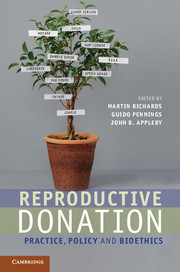Book contents
- Frontmatter
- Contents
- Contributors
- Acknowledgements
- 1 Introduction
- 2 The biology of donation
- 3 Ethics for reproductive donation
- 4 Parenthood – whose right is it anyway?
- 5 Reproductive donation
- 6 UK and US perspectives on the regulation of gamete donation
- 7 Gamete and embryo donation
- 8 The legal and ethical regulation of transnational donation
- 9 Balancing ethical criteria for the recruitment of gamete donors
- 10 Challenges in intra-family donation
- 11 ARTs and the single parent
- 12 Reproductive donation and justice for gay and lesbian couples
- 13 Is disclosure in the best interests of children conceived by donation?
- 14 Identifiable donors and siblings
- 15 Ethical issues in embryo donation
- 16 Reproduction through surrogacy
- 17 Some conclusions regarding the interaction of normative and descriptive elements in reproductive donation
- Index
- References
2 - The biology of donation
Published online by Cambridge University Press: 05 August 2012
- Frontmatter
- Contents
- Contributors
- Acknowledgements
- 1 Introduction
- 2 The biology of donation
- 3 Ethics for reproductive donation
- 4 Parenthood – whose right is it anyway?
- 5 Reproductive donation
- 6 UK and US perspectives on the regulation of gamete donation
- 7 Gamete and embryo donation
- 8 The legal and ethical regulation of transnational donation
- 9 Balancing ethical criteria for the recruitment of gamete donors
- 10 Challenges in intra-family donation
- 11 ARTs and the single parent
- 12 Reproductive donation and justice for gay and lesbian couples
- 13 Is disclosure in the best interests of children conceived by donation?
- 14 Identifiable donors and siblings
- 15 Ethical issues in embryo donation
- 16 Reproduction through surrogacy
- 17 Some conclusions regarding the interaction of normative and descriptive elements in reproductive donation
- Index
- References
Summary
Introduction
It is commonly asserted that new technologies drive political, social and ethical changes. However, such influences are rarely unidirectional (Theodosiou and Johnson, 2011); indeed, historically the technologies and practices of sperm donation were themselves much influenced by social, ethical and political considerations. However, the advent of in vitro fertilization technology undoubtedly provided a powerful stimulus to sperm, embryo and egg donation, and the nature of many of the ethico-socio-political issues generated were themselves resolved or changed by the further refinements of single sperm injection, and the capacity to freeze and store gametes and embryos. Whether these technologies can or should be applied or not, and if so how, is of course much influenced by socio-ethical factors. This chapter examines some of the basic medico-scientific issues as a background to the complex and bidirectional interactions with ethics that follow.
Infertility and sterility
Fecundity is a measure of reproductive potential, and where that potential is zero, the individual (or couple, or population) is said to be sterile. In contrast, fertility is a measure of reproductive outcome and is usually expressed in terms of children born per woman, per couple or per population unit. Infertility is a measure of the failure to produce children, and is variously defined as occurring after a specified period of time – for example one or two years of attempts. Infertility may result from sterility but not necessarily so; a sole individual or two of the same sex will be infertile however long they try for children, but need not be sterile. This distinction has led to the concepts of medical and social infertility, and both are the subjects of this volume.
- Type
- Chapter
- Information
- Reproductive DonationPractice, Policy and Bioethics, pp. 13 - 29Publisher: Cambridge University PressPrint publication year: 2012

